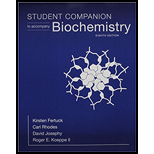
Concept explainers
Interpretation:
The function of glycerol 3-phosphate, phosphatidate, diacylglycerol in the formation of triacylglycerol and phospholipid. should be determined.
Concept introduction:
Phospholipids are the basic constituent of all cell membranes. They usually form lipid bilayers. The structure of a phospholipid molecule has a tail made up of two hydrophobic fatty acid and a hydrophilic head comprising of a phosphate group.
Answer to Problem 1P
Glycerol 3-phosphate, phosphatidate, and diacylglycerol act as a precursor for the formation of triacylglycerol and phospholipid.
Explanation of Solution
Glycerol 3-phosphate acts as the base for the formation of both triacylglycerol and phospholipid. Glycerol 3-phosphate is a glycolytic chemical intermediate. Glycerol 3-phosphate is synthesized typically by the reduction of dihydroxyacetone phosphate (intermediate of gluconeogenesis).
Formation of phosphatidate:
Phosphatidate is formed during the initial step of the production of both triacylglycerols for energy storage and phospholipids for membranes.
Glycerol 3-phosphate become acylated by the acyl CoA. It then forms lysophosphatidate. Then this lysophosphatidate is again acylated by acyl CoA to form phosphatidate.
Formation of triacylglycerol:
During the formation of triacylglycerol, the phosphoryl group is eliminated from glycerol-3 phosphate to synthesize diacylglycerol. This diacylglycerol is then acylated to produce triacylglycerol.
Formation of phospholipid:
During the phospholipid production, phosphatidate usually reacts with Cytidine triphosphate or CTP. This reaction produces CDP-diacylglycerol. Then CDP-diacylglycerol further reacts with alcohol and produce a phospholipid. Instead, diacylglycerol can also react with a Cytidine Diphosphate or CDP alcohol to synthesize a phospholipid.
In this way, glycerol 3-phosphate, phosphatidate, diacylglycerol play an important role in the formation of triacylglycerol and phospholipid. These molecules act as a precursor for the formation of triacylglycerol and phospholipid.
Glycerol 3-phosphate, phosphatidate, and diacylglycerol act as a precursor for the formation of triacylglycerol and phospholipid.
Want to see more full solutions like this?
Chapter 26 Solutions
Student Companion for Biochemistry
- Disadvantages of cholesterolarrow_forwardWorking at cross-purposes? Gluconeogenesis takes place during intense exercise, which seems counterintuitive. Why would an organism synthesize glucose and at the same time use glucose to generate energy?arrow_forwardBIOMOLECULES - MULTIPLE CHOICE - Please answer properly QUESTION : In human beings, what is the major control of de novo pyrimidine nucleotide synthesis? A. substrate availability B. competitive inhibition of carbamoyl phosphate synthetase II C. feedback inhibition of glutamine-PRPP amidotransferase D. vailability of N-acetyl glutamatearrow_forward
- MULTIPLE CHOICE In patients with Lesch Nyhan Syndrome, purine nucleotides are overproduced and over excreted. The hypoxanthine analogue Allopurinol, which effectively treats gout , has no effect on the severe neurological symptoms of Lesch- Nyhan patients because it does not A. decrease de novo pyrimidine synthesis B. decrease de novo purine synthesis C. decrease urate synthesis D. increase PRPP levels (Phosphoribosyl pyrophosphate)arrow_forwardAssignment on KetohexosesConstruct the structure of the following enantiomers or mirror images:1. D and L Fructose2. D and L Allulose3. D and L Sorbose4. D and L Tagatosearrow_forwardChymotrypsin information about enzyme? Trivial/Common Name Systematic (EC) name and number Chemical reaction catalyzed Metabolic pathway Function and cellular localization Size (kDa) and structure (tertiary and quaternary) pH stability Kinetic properties (Km- and Kcat value/s for natural substrates) Stability and potential inhibitorsarrow_forward
- BIOMOLECULES - Please answer the questions properly. - Multiple choice 1. In human beings, what is the major control of de novo pyrimidine nucleotide synthesis? A. substrate availability B. feedback inhibition of glutamine-PRPP amidotransferase C. competitive inhibition of carbamoyl phosphate synthetase II D. availability of N-acetyl glutamate 2. In patients with Lesch Nyhan Syndrome, purine nucleotides are overproduced and over excreted. The hypoxanthine analogue Allopurinol, which effectively treats gout , has no effect on the severe neurological symptoms of Lesch- Nyhan patients because it does not? A. decrease de novo pyrimidine synthesis B. increase PRPP levels (Phosphoribosyl pyrophosphate) C. Decrease urate synthesis D. decrease de novo purine synthesisarrow_forwardSerine protease enzyme mutation To show differences in the effect of the nucleophilic attack of the carbonyl group (C=O) of peptide bond between the catalytic triad of serine, histidine and aspartic acid, and another catalytic triad contains alanine, histidine and aspartic acid Provide/ draw an example of catalytic mechanism with catalytic triad contains alanine, histidine and aspartic Please answer completely will give rating surelyarrow_forwardExponential expansion? Compare the amount of information inherent in the genome, the proteome, and the glycome.arrow_forward
- Modified true or false. Replace the underlined word if false. Glucagon inhibits beta-oxidation, but stimulates fatty acid biosynthesis.arrow_forwardActivity: Write the line structure of each of the following peptide at pH7 and identify how many peptide bond in each number. 1. Glycyl-valyl-serine 2. Threonyl-cysteine 3. Isoleucyl-methionyl-aspartatearrow_forwardPharmacokinetics of cyclophosphamidearrow_forward
 BiochemistryBiochemistryISBN:9781305577206Author:Reginald H. Garrett, Charles M. GrishamPublisher:Cengage Learning
BiochemistryBiochemistryISBN:9781305577206Author:Reginald H. Garrett, Charles M. GrishamPublisher:Cengage Learning
